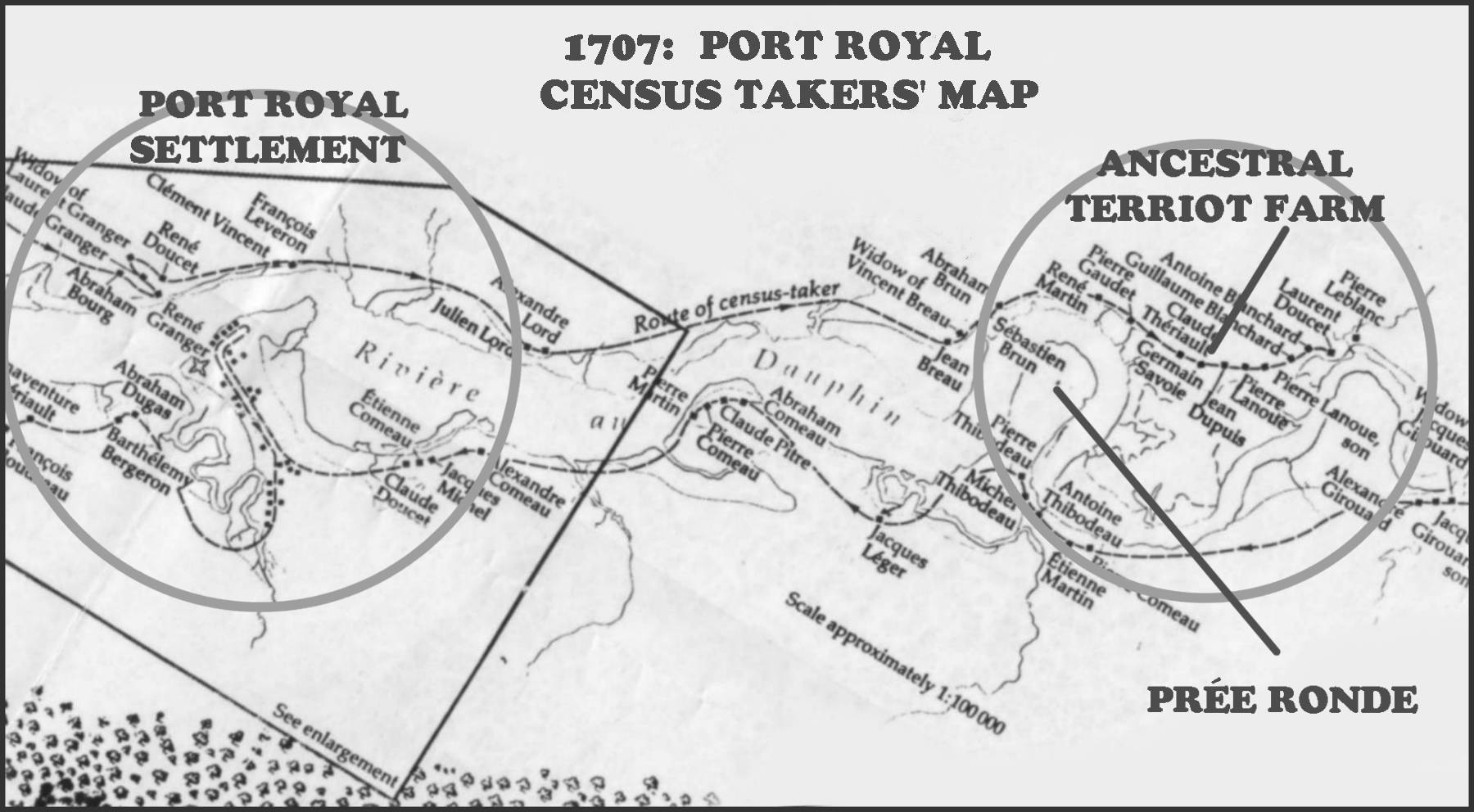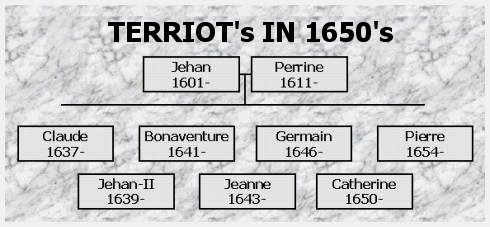This
new section will try to consider whether the Acadian treatment at the hands
of the English (and the French) was largely propaganda and deceit than
it was honest intentions and factual truth. What was the English plan?
What were their motives? What role did the American colonies play
in the development of Acadia? What role did the colonies play in
the Great Eviction? Did the English in fact plot to separate the families
as part of their goal to evict the Acadians?
We
will consider these issues while we interpret this history in terms of
our Terriot family. As these events were unfolding, where were Jehan's
children? ... his grandchildren? What was happening to them? Did they participate
in defending themselves against the attacks by the English? Did they participate
in the development of the other settlements in Acadia like Grand Pré,
Beaubassin and others? What do we know of the settlements and the neighborhoods?
And finally, in the period immediately preceding the Great Eviction, which
of our ancestors chose to leave and which chose to remain as unwitting
victims of the English plan for the Great Eviction.
PROLOGUE
We will now shift
our focus to the the next 100 years of Acadian history beginning in 1650.
This was a time during which the promise of Acadia molded the Acadian
culture for those generations who lived during and following the tragic
times of the Great Eviction. The early decades were a time of peace and
prosperity shattered often and unprovoked by violent attacks as a result
of the wars either between England and France, or between the New England
militia and the French nobility in Acadia, or among the French nobility
itself in Acadia. But still the Acadian culture thrived and produced a
great bounty. This was a time when the Acadians learned to live and survive
on their own; ...when they developed their sense of independence from foreign
powers including France; ...when they developed the skills for self-government,
shed the oppressive yoke of feudal culture and embraced an egalitarian
ethic. This occurred a full century before the founding of democracy in
America and France. In this next century, the Acadians will grow from a
few hundred to over 15,000. Their cultivated lands will grow to more than
13 thousand acres of rich farmland and their cattle will number in the
hundreds of thousands.
One of the writers
on Acadian history, Edouard Richard, an Acadian descendant and ex-member
of the House of Commons of Canada, sets the scene for the unfolding decades
of Acadia:
"Nothing,
to my mind, is more captivating than the story of this province from 1604
to 1710. It is to America what Greece once was to Europe, and the Bay of
Fundy evokes almost as many memories as the Aegean Sea. The scenes there
enacted have been so various and so dramatic, the actors thereof give one
such an impression of heroism and of half-savage grandeur, that one can
hardly refrain from treating them as legendary, as if they belonged to
an epoch that is lost in the mists of antiquity. Biencourt, d'Aulnay,
the
de
la Tours, Saint-Castin, Denys, Subercase, Morpain, are so many legendary
heroes whose names are still re-echoed by forest and rock from New Hampshire
to the inmost of the Bay of Fundy."
 Add
also to this drama, the peaceful, faithful but independent Acadian who
refused to be a pawn in this drama and was intent on creating a future
for his family. He formed a bond of friendship and trust with his native
neighbors, offered his loyalty to those who would accept it and continued
to persevere in spite of that drama. Another writer of history, Francis
Parkman (a Bostonian), saw that the "the eventual success of the British
represented the victory of progress [Protestant democracy] over reaction
[Catholic despotism]." Had he been able to see beyond his prejudice, he
would have seen the tolerant nature of the Acadian common man instead of
the harsh dogmatic nature of the Catholic hierarchy at that time. He would
have seen the egalitarian sense of the Acadian common man against the tyranny
and ruthlessness of the English which was epitomized by Charles Lawrence. Add
also to this drama, the peaceful, faithful but independent Acadian who
refused to be a pawn in this drama and was intent on creating a future
for his family. He formed a bond of friendship and trust with his native
neighbors, offered his loyalty to those who would accept it and continued
to persevere in spite of that drama. Another writer of history, Francis
Parkman (a Bostonian), saw that the "the eventual success of the British
represented the victory of progress [Protestant democracy] over reaction
[Catholic despotism]." Had he been able to see beyond his prejudice, he
would have seen the tolerant nature of the Acadian common man instead of
the harsh dogmatic nature of the Catholic hierarchy at that time. He would
have seen the egalitarian sense of the Acadian common man against the tyranny
and ruthlessness of the English which was epitomized by Charles Lawrence.
As acknowledged by
several other historians and writers including Thomas Chandler Halliburton,
Beamish Murdoch, Hannay, Phillip H. Smith, Casgrain but articulated so
well by a contemporary writer from Louisiana, Clive Doucet in his
book "Notes from Exile, On Being Acadian",
"the Acadians'
independent, democratic ethic presaged the modern era, which arrived powerfully
almost a generation later (after the Great Eviction) with the American
and French revolutions."
Their egalitarianism
was foreign not only to the English and the French but also foreign to
their cousins to the north in New France. Could it be that the Acadian
model may have inspired the American founders... in this Promise of Acadia?
1650's:
Children of Acadia Come of Age; Acadian Self Rule
THE
POLITICAL SCENE
With d'Aulnay
now 'out of the picture', La Tour sees an opportunity to consolidate
his control of the colony. In a clever, strategic move, he marries the
widowed Madame d'Aulnay in 1651 (at the age of sixty) and together they
have five children! While this event certainly put an end to the D'Aulnay
/ La Tour feud, it did nothing for the next round of the 'Baronial Feuds'.
In his work of recruiting
French colonials for Acadia, d'Aulnay had generated some very serious debts
with several creditors, one of which was Emmanuel
Le Borgne who came to Acadia in 1654 (on the same ship as Pierre
Thibodeau). Le Borgne with support from others and in La Tour's absence,
seized Port Royal which created another round of feuds with the La Tour/d'Aulnay
family. But ultimately (to make a long saga short), his son, Alexandre
married one of the daughters born of La Tour and Mme d'Aulnay and thus
consolidated several competing claims to land and power.
But an even more
bizarre development in 1654 brought the on-going feuds and battles to a
point of ridiculous. Back in Massachusetts, Robert Sedgwick had
armed the colony's forces to take New York from the Dutch. As they set
out on their adventure, peace was negotiated leaving the 'fired up' troops
ready for action but with no mission. In the meantime, England's Cromwell,
seeing how little France cared for its colonies, conceived the idea of
seizing Acadia during the Dutch conflict and directed Sedgwick to send
his forces north to harrass the French and Acadians. They captured Penobscot,
St-John and completely surprised La Tour in Port Royal. Until well into
the next decade, Sedgwick left Port Royal in the charge of a council of
Acadians led by Guillaume Trahan... a most significant event for
the Acadians.
THE
ACADIANS
Prior to Sedgwick's
attack in 1654, it had become clear to the Acadian settlers that La Tour
was not interested in leading them but was interested largely in the political
and financial rewards associated with Acadia. So leaving the Acadians to
manage their affairs was of mutual benefit to all. Thus, even with the
feuding between the 'nobility', the Acadians in Port Royal continued to
make progress in developing their families, their livestock, their facilities
and their lands. Their children came of age during this decade and soon,
that generation would be assuming the workload. The Acadian population
grew from a few immigrant families established at Port-Royal in the late
1630's and 1640's to an estimated forty families now living at Port Royal.
A high birth rate and low infant mortality led to rapid population growth.
By continuing with
d'Aulnay's strategy of building and maintaining dikes, the Acadians were
able to cultivate the marshes which, after freshening for a few years,
made excellent ploughland. The Acadians also cleared and farmed upland
(undiked fields), but of course they preferred the more fertile land that
they could obtain by diking.
The principal field
crops were wheat and legumes supplemented by oats, rye, barley, and flax.
Cattle were the dominant livestock, but most farmers also kept pigs, sheep
(for wool), and poultry. Every farm had a kitchen garden. Almost every
year the Acadians shipped furs, feathers, wheat and beef to New England
via several English stores in Port-Royal. But agriculture was and would
continue to be primarily subsistent. Supplemented by the local resources
of sea and forest, marshland farms provided most material needs.

THE
TERRIOT's: Port Royal
As we mentioned
before, the Terriot's had settled about 10km east of the new Port Royal
location along the northern bank of the Rivière au Dauphin river
where the river makes a hairpin turn. To give you a sense of the 'neighborhood',
we will use a map that is based on the route that was used by the census
taker in the census of 1707. (You may left click on the map to zoom.)
In the area labeled
"ANCESTRAL TERRIOT FARM", you can see the Claude Terriot habitation
which Claude probably inherited later from his father in the 1660's. But
at this point in the 1650's, the
family names (perhaps not the specific
individuals listed in the map) were about the same as they are shown on
the map with perhaps a few exceptions. One such exception was Pierre Thibodeau
who arrived from the Poitou area in 1654 and settled across the river from
the Terriot's on the inside of the 'hairpin turn' which came to be called
the 'Prée Ronde'... and incorrectly translated later by the English
to "Round Hill". It is interesting to note that Pierre was part of a group
of settlers that was hired by Emmanuel Le Borgne and who accompanied the
settlers on board the 'Châteaufort' from Belle Isle, France[ref:
31,
33].
 Jehan
and Perrine completed their family during this decade with Catherine and
Pierre in 1650 and 1654, respectively. With four sons, Jehan's family had
a fair chance of emerging as one of the more successful 'habitants / farmers'
in Port Royal. But as you will see later, it does not appear that this
was a first consideration in Jehan's mind. Jehan
and Perrine completed their family during this decade with Catherine and
Pierre in 1650 and 1654, respectively. With four sons, Jehan's family had
a fair chance of emerging as one of the more successful 'habitants / farmers'
in Port Royal. But as you will see later, it does not appear that this
was a first consideration in Jehan's mind.
In this decade, he
and Perrine would see Claude 'come of age' followed by the others. So,
their family is now maturing and their elder children are beginning to
form adolescent relationships with other Acadian youth in the settlement.
In 1653, Claude celebrated his 16th birthday and no doubt had already developed
an interest in the Gautherot girl living in the 'neighborhood'29,
The other sons, Jehan (II) and 'Venture' turned 16 in 1655 and 1657, respectively.
With his sons, Jehan
continued to try to expand his improved acreage by clearing more of his
land, pulling the stumps with his oxen and begin a process of tilling and
cultivating the land. But there was still much work to be done with the
communal projects which included additional buildings in the village of
Port Royal and of course the diking projects. This work along with the
'distractions' associated with the feuds between the nobility and the spurious
attacks from the colonies and the English, surely took Jehan away from
his work of increasing his acreage because by 1671, he still had fewer
than 10 acres of improved land.
It is not clear to
what extent the settlers including the Terriot's were involved and affected
by the attacks on the village of Port Royal. The Terriot farms were about
10km up-river from the village of Port Royal. But, Jehan, now 53 and his
son, Claude now 17 and possibly even Jehan (II) now 15 were probably involved
in 1654 in defending Port Royal against Sedgwick's forces from Massachusetts.
But the other skirmishes between the 'feuding Lords' may not have involved
the settlers who were some distance from the fort and the village.
|